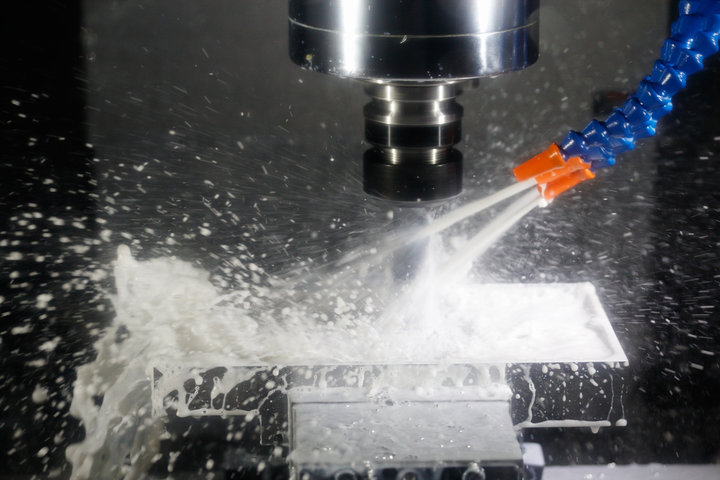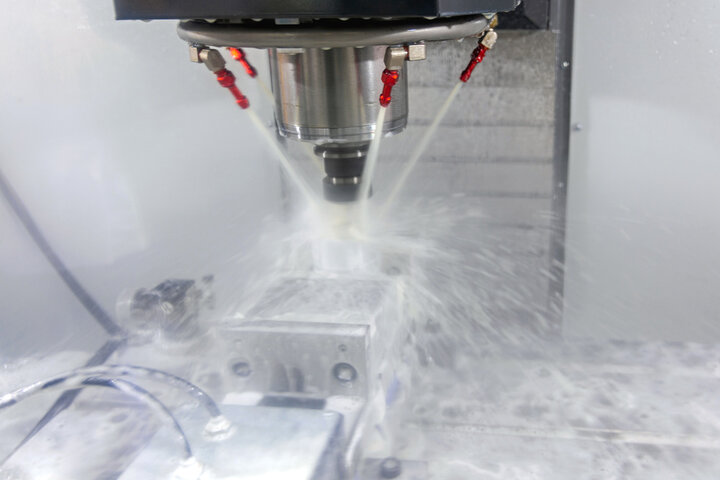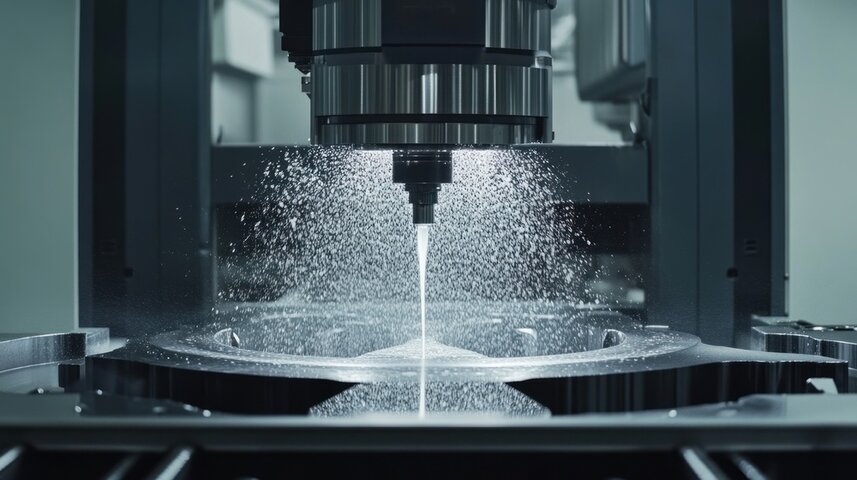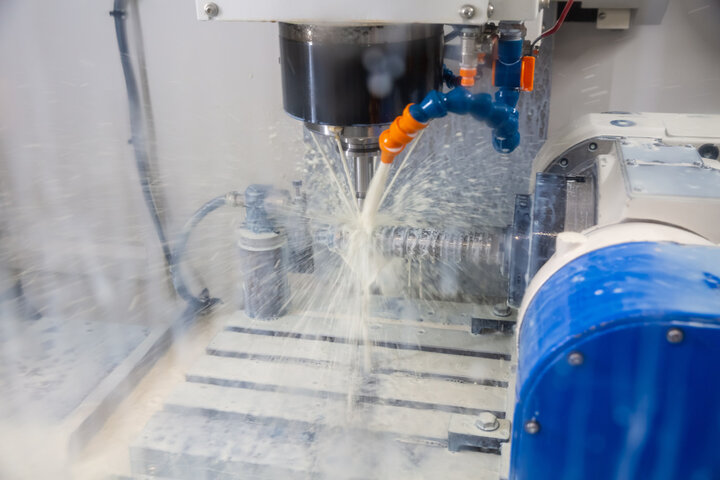Have you ever wondered why proper cooling makes such a difference in CNC machining? Smart cooling technology, delivered through precision coolant nozzles, serves as your machine's vital cooling system. These high-performance cooling methods protect tools from heat damage, wash away chips, and maintain tight tolerances.
By optimizing your machine coolant technology, you can achieve better finishes, faster cutting speeds, and longer tool life. In this blog, we will inform you of definition, applications, features and maintaining tips on CNC coolant nozzles, providing you professional suggestions on choosing best coolant nozzles For CNC machines.

Understanding Machine Coolant Technology
Numerically controlled fluid enriches the working of the structure with its thermal fluids reach to the right areas of contact with great precision. The cooling method works in such a way that there is an equilibrium in pressure and in the flow of fluid so that the right quantity of fluid will reach the desired point with utilization of appropriate nozzles. It minimizes heat losses per glass, and thus, significantly reduces thermal stress on the cutting edges of tools and the workpiece.
The concept also implemented an innovative cooling system which consists of several advanced sensors and programmable controllers that helps to adjust the properties of the coolant according to the requirements of the manufacturing product. This control centers on the ability of the coolant system to cope with high processing rates by adjusting the direction and speed of the flow and the demanded level of fluid pressure necessary for spreading this fluid for maximum achievable cooling effect.
The use of different modes and optimal cooling strategies makes it possible, thus precision machining in these undesirable conditions may be economic. All this features pressurized cooling within multiple-point systems which offers the benefits of both conventional flood cooling in addition to high speed through spindle techniques. This brings the best efficiency as far as heat removal is concerned coupled with the minimum cost of the coolant which results in excellent surface finishes as well as increased tool life and productivity levels in critical areas.

Types of Industrial Coolant Nozzles
1. Fixed-Position Nozzles
Characterized by: Stationary installation, Easy set-up, Stable spraying pattern, Negligible maintenance simplify
Suitable for: Basic Milling Operations, Primary Machine Shop Turning Processes, Secondary General Purpose Machining, Other High-production Output (Enhanced) Processes
Fixed-position nozzles discharge metalworking fluid through carefully located, firmly fixed coolant outlets surrounding the cutting tool zone. These metalworking nozzle assemblies are used for cooling purposes during the process, therefore, adjustment is unnecessary while working. Such systems can be used in routine cutting operations, if the machining velocities are less likely to vary.
2. Articulating Nozzles
Characteristics: adjustable position, the presence of joints, the existence of several axes of x, y, z, and rotation of the movement and existence of «quick-release clutch».
Applicability: the availability of complex geometric shapes, machining of products with various sides, the performance of work with changeable tools, manufacturing products.
One of the trade-related characteristics of spraying nozzles is presence of the flexible elements, which can be adjusted by the operator with his or her hands for more accurate positioning of the cooling liquid-supplying system. This enables the operator to arrange the coolant distribution system more favorably as regards both the tool move in consideration and its arrangement in the space against the workpiece, and also to cool it satisfactorily given the complex geometrical form of the machining operation.
3. Through-Tool Coolant Nozzles
Characteristics: cylindrical coolant drilling, Optimal flow distribution, fine outlet adjustment, Integrated in the tool
Worth for: Deep hole drilling, High-speed cutting, Hard-to-cut materials, Dimension-specific components
Internal and external through-tool coolant systems dispatch high pressure coolant within the drilling tool channels passing through the cutting edge itself. This arrangement is primarily incorporated to the design to optimally reach the cutting edge with the coolant, in order to manage the heat most effectively during production, especially in such cutting environments where chip evacuation and heat NOT are the major concerns.
4. Programmable Nozzles
Characteristics: CNC programmed directioning, Mechanical adjustments automated, Different kinds of flows, Interrelations of nozzle and sensors
Operations: Advanced 5-axis machining, Adaptive manufacturing, Smart factory integration, Complex part production
Programmable nozzles are designed to have a full control system that includes motion control done by a servo motor. This allows the system's electronic controls to automatic position as well as flow characteristic adjustment depending on machining parameters. It is then realized that such systems are utilized very well for purposes of optimizing the cooling process by delivering coolant in sync with the tool's movement and cutting situation.
5. High-Pressure Nozzles
Features: Reinforced construction, Specialized orifice design, Pressure ratings >1000 PSI, Tungsten carbide tips
Applications: Titanium machining, Aerospace components, Heavy chip formation, Super alloy cutting
High-pressure nozzles produced with a view to transmitting coolants at high pressures shall be preferred due to the necessity to use their high velocity fluid jets for cutting. This system works best when it comes to chip breaking and cooling off hard-to-machine materials when the ordinary methods of cooling are insufficient.
Technical Specifications and Performance in CNC Cooling Solutions
Flow Control Parameters
Precision survival of a sump system in a machine fluid such as oils, water or cutting fluids, is achieved through the liquid circulation, keeping the following parameters in view: flow rate 2 – 20 L/min, pressure 5 – 100 bar for regular uses and 1000 bars for high-pressure undiluted cooling, and thickening involves the consistency that matches that of the cutting fluids. Such technological computer systems observe the immediate variations of these values without distant periodic checking thanks to these real-time device sensors and control valves.

Temperature Control and Heat Management
If the new cooling factor will be approved, it should be able to control the temperature with a degree of accuracy of ±2° C. The dynamics of the splashing method is subdivided according to the zones of interest, thereby the load is controlled by some means such that between the tank and the pumps with an input temperature of about 20-25° C for the high level of machining the load is around 50Kw.
Advanced Spray Patterns and Coverage
Precision coolant distribution apparatuses are designed to apply uniform spatter patterns in the course of a machining process. Spatter specifics include the following:
Angle of distribution is from 15 to 90 degrees in consideration of percentage of distribution.
Droplet volume is within the range of 10 to 100 microns with an aim to penetrate the droplet containing compartment.
Velocity range from 10 to 60 m/s and is governed by the particular application at hand.
95% level of distribution consistency at the required 15 degrees.
Cooling Performance Standards
Cooling nozzles that will deliver high performance, must as per the industry’s standards be more reliable and effective:
• Kept stable within the set limits: within +/- 5%
• Controlled waters with a response time of shall be faster than 100ms for examples where systems are used.
• Consistent pressure of fluids: deviations remain within ± 2% under normal functioning.
• Uniform temperature states: the difference between and the temp along the cooling zone will not exceed± 1C.
• Work life: 5000 hours under steady state conditions without any breaks should be assured.
Applications of Industrial Coolant Nozzle
Advanced Aerospace Manufacturing
Main Characteristics: High-precision cooling nozzles, devices with CNC temperature control, Multiple cold-readiness systems, and intelligent cooling technology
Industrial domains: Parts of turbines, Metallurgical elements, Airframe components, Titanium processing
When it comes to the manufacture of aero components, precision coolant delivery systems is indispensable for adhering to the continued demands of the market, in terms of high accuracy and perfect finish. It means, effective machining of heat-resistant super-allied materials and titanium in particular is possible as well as the production is stable across intricate and complex forms or for important parts.
Automotive Production Line Systems
Key Features: Machine coolant technology, CNC fluid management, Quick-change nozzle assemblies, High-volume cooling solutions
Applications: Engine blocks, Transmission parts, Brake components, Precision drivetrain elements
The production of automobiles is impossible without remarkable cooling solutions capable of working full time and keeping strict quality. Advanced nozzle systems support the worked under standard types of machining process as well as precision machining processes’.

Precision Medical Device Manufacturing
Key Features: High-precision spray control, cooling equipment for industrial use or air-conditioning cooling equipment, a spray method for applications in a single drop, an improved spray application
Applications: Implant components, General surgery instruments, Medical diagnostics equipment, High-precision medicine parts (nurers’ ability).
The production levels necessary for medical tools attachers constitutes very high and precise operating templates for cooling lubricants. The application of plasma spray technology allows surgical tools manufacturers to keep a sterilized environment and cool very accurately around the machining of hard-to-work biocompatible materials and delicate medical implants.
Heavy-Duty Energy Sector Components
Key Features: Machine part cooling systems, Extended reach nozzles, High-pressure coolant nozzles, Durability
Applications: Turbine components, Pipeline fittings, Power generation parts, Heavy equipment elements
The manufacturing process in the power sector typically involves the machining of very large components which require efficient cooling systems. There are industrial coolant nozzles that cope with the rigorous machining conditions whist ensuring cooling performance is kept constant even for long periods of machining.
High-Precision Electronics Industry
Key Features: Fine-mist nozzle control, CNC heat management, Efficient cooling solutions, Clean operation
Applications: Heat sinks, Circuit board components, Connector parts, Precision electronic housings
High-quality modern electronics manufacturing has necessitated advanced cooling technology applications which are also very careful at effective rate of performance. Another advanced method that is used for effective cooling is the quality method called smart cooling which delivers specific cooling, prevents insensive components from overheating and avoids more pollutants from getting in air.
Essential Tips for Selecting Best Coolant Nozzles For CNC Machines
Match Machine Technology Compatibility
To ensure the quality of the proposed CNC fluid management systems, it is necessary to determine the range of pressure that it can handle (20-1000 bar), the total amount of flow that is to be supplied (2-20 L/min), as well as how and where it is supposed to be – mounting specifications. It is necessary that clever cooling treats the machine as an ordinary mechanical or hydraulic system and it is controlled through the coolant control of a machine without any modification to its coolants
Evaluate Process Requirements
It is necessary that this includes some types of more advanced machining such as turning or users who are considering some type of machining center technology and also lifting machines above any material speed or feed rates. This does not necessarily mean that their entire operation will be of high-performance, but this template will also improve the effectiveness of machines with other tools other than jig boring on the workpieces.
Compare Advanced Features
Fly walls capable of adjusting spray angles, work piece location, in action and height of work piece, also pressures within a range of cook off temperature, most of them are also fully programmable—such are the substances of machine controllers. Machine coolant technology that allows for rapid adjustments to its configurations for example by adopting the use of quickchange filled in tanks, and with a through the spindle tool carrier enhances operation efficiency.
Verify Construction Quality
The available resources manage to include much industrial coolant nozzle materials, wear, and the ability it gives. It must be cold in the working area, count failures of cooling solutions and optimize performance within its warranty period.
5. Analyze Long-term Value
Find sum of money that have been spent i.e. purchase cost, installation expenses, and upkeep volume. It may be also be true that installation of cooling systems with high-performance nozzles pays back more than those with low-cost nozzles, due to the improvement in the life expectancy of tools, the reduction of breakdown time and the improvement of the quality of the parts.
Essential Tips for CNC Coolant Nozzle Maintenance
1. Daily Inspection of Machine Coolant Technology
Sight whether the nozzles of the system are intact and check whether they are clean. Look at how the nozzle sprays and how its condition is like wearing or corrosion. Make sure the nozzles are well fitted and the coolants will not continuously drop and cause a mess. When this is not done in a timely manner, the cooling system is not very ideal for use when engaging in mass production.
2. Cleaning and Servicing HighPressure Cooling Systems.
One way of cleaning is the use of non-chemical techniques that involve the use of cleaning devices to eliminate the build-up. In most cases, the use of mechanical devices and chemical products will suffocating, burnish coolant residues on the components of the CNC spray technology. With this cleaning reservoir, the liquid flow will be regular and the coolant will not remain unevenly distributed.
3. Monitor Smart Cooling Technology Parameters
Check and compare the readings on the flow meters and the pressure gauges of modern nozzles against the standards. Abrupt variations in conditions of machine lubrication points to the possibility of deposits clogging filtered systems or mechanical abrasion caused by wear. With routine inspection, one can control exposure to damage that may affect the consistency of the cutting or grinding process.
4. Verify the Enhanced Cooling Systems’ Spray Patterns
Update the atlas of the patterns and make sure your precision coolant delivery equipment works. Using a clear and understandable machinery cooling process manual, specify the current patterns of CNC cooling systems to provide approval for their use. Making sure the device is working as intended is necessary because the coolant must be delivered clearly hence covering all the zones to be machined through the industrial coolant nozzles.
5. Maintain Coolant Delivery Networks
Follow the manufacturer’s specifications and instructions for replacing any type of filters or screens. Observe the levels of pressure drop in high-performance cooling systems and look for symptoms of cross contamination. Use of good and reliable filters can assist in stopping any impurities from getting to the CNC air spraying equipment while keeping the flow rate of the coolants constant at the same time.
6. Professional Assessment of Cooling Solutions
Annually, the cooling solenoids whether part specific or the separate MODULEIC solenoids shall be full inspected. Such an inspection shall range from nozzle control systems pressure test, thin out and flow check, to looking closely at the components for wear and tear. Expert assessment helps to avoid problems in the CNC cooling system.

Elevate Your Machining Precision with Team MFG's Advanced Coolant Technology
Transform your CNC operations with Team MFG's innovative coolant delivery networks. Our smart cooling technology features precision-engineered nozzles delivering optimal coolant exactly where needed. Experience up to 40% longer tool life and 30% faster cutting speeds with our high-performance cooling solutions.
Whether you're machining aerospace components or automotive parts, Team MFG's advanced CNC fluid management systems ensure superior surface finish and unprecedented accuracy. Maximize your productivity today with industry-leading coolant control technology.
Contact us right now!
Frequently Asked Questions (FAQs) About Coolant Nozzles For CNC Machines
Q: What is the primary function of CNC coolant nozzles in machining operations?
By smartly making use of small and precisely employed operations which direct the pressurized cooling fluids to respective cutting zones, we are able to control the heat generated by the machining operation, remove the chips and at the same time help in the extension of the tool life and the improvement of the surface of the rough part with the help of a high precision coolant distribution.
Q: How do high-pressure coolant nozzles differ from standard flood cooling systems?
These high-performance nozzles work under extreme high pressure conditions and pressures above 1000 PSI are mostly achievable to enhance chip breaking and the dissipation of heat. Conventional flood cooling uses comparatively low pressures (50-300 psi) for supplying coolant to the cutting tool as well as water to work as lubricant as a flood.
Q: What pressure and flow rates should I use for different machining operations?
This will depend on the exact operation you are trying to perform: Conventional face milling will generally range between 300 – 500 psi and 2 to 5 gpm coolant rates, Internal gun drilling on the other hand will be in a range of 800 – 1200 psi and the coolant will range from 4 to 8 gpm, and for High-speed machining with a lathe, 500 – 1000 psi is applied and flows of 3 – 6 gpm are recommended.
Q: Why would I choose through-tool coolant nozzles over external cooling?
Through-tool coolant delivery networks provide direct access to cutting edges, especially beneficial for deep holes and internal features where external nozzles cannot effectively reach the cutting zone.
Q: How do I optimize spray patterns for different cutting tools?
Modify the parameters of the cnc axis when it comes to fluid management so as to fit in all the tools and how they cut. Adjust the 15 to 90-degree spray angle of the tool to the matching diameter and cutting relief face of the tool.
Q: What do you observe to be symptoms of the coolant nozzle failing or deteriorating?
Analyze the nature of the spray, if it is not uniform, if the pressure is not steady, if the tool works have come to a stop faster than expected, and swing sparks are present giving the impression that chip formation is not uniform. Keeping in mind the machine coolant technology, it should always be in a position to maintain consistent pressure and flow values well within the prescribed limits.
Q: How often should I perform maintenance on industrial coolant nozzles?
Look at the nozzles visually everyday. Clean the nozzles every week keeping the nozzle tips tidy. Check the flow of water in the nozzles monthly. Also, carry out the checks of efficient cooling solution components every three months in order to make visual inspection of metalworking equipment.
Q: What safety protocols should I follow when working with high-pressure cooling systems?
Before starting any maintenance work, always check and make sure that there is an appropriate pressure release system in the high pressure air/water line. Put on the protective equipment required, make sure that all of the energy sources are completely locked out and tagged, also operate the related CNC spraying device safely by completing additional education and training.
Q: How can I prevent clogging in precision cooling nozzles?
A clogging in a precision cooling nozzle involves inclusion of proper Precision nozzles and in particular how clogging can be avoided. Achieving this goal entails instituting proper filtration levels for the coolant, frequent cleaning of the Precision nozzles, proper coolant blends and ensuring repeat maintenance activities of the better injection systems.
Q: What specifications should I consider when upgrading my coolant delivery system?
Some of the factors to consider in the modernization of cooling system are the level of efficiency, pressure requirements, flow rates, availability of the floor for nozzle positioning, ease of integration and implementation of proactive cooling systems, and payback period of the new nozzle systems.
For more questions, contact TEAM MFG today!



















